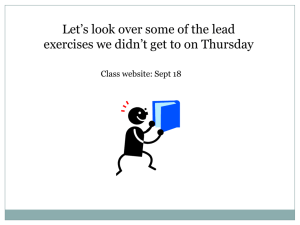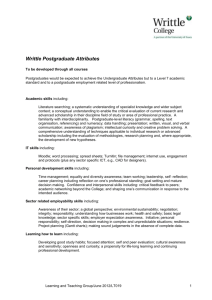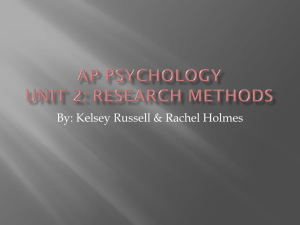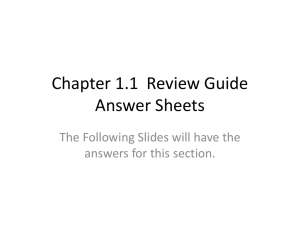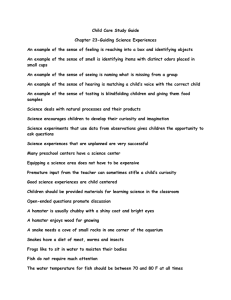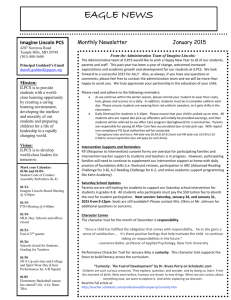Using Instructional Design Strategies to Foster Curiosity
advertisement
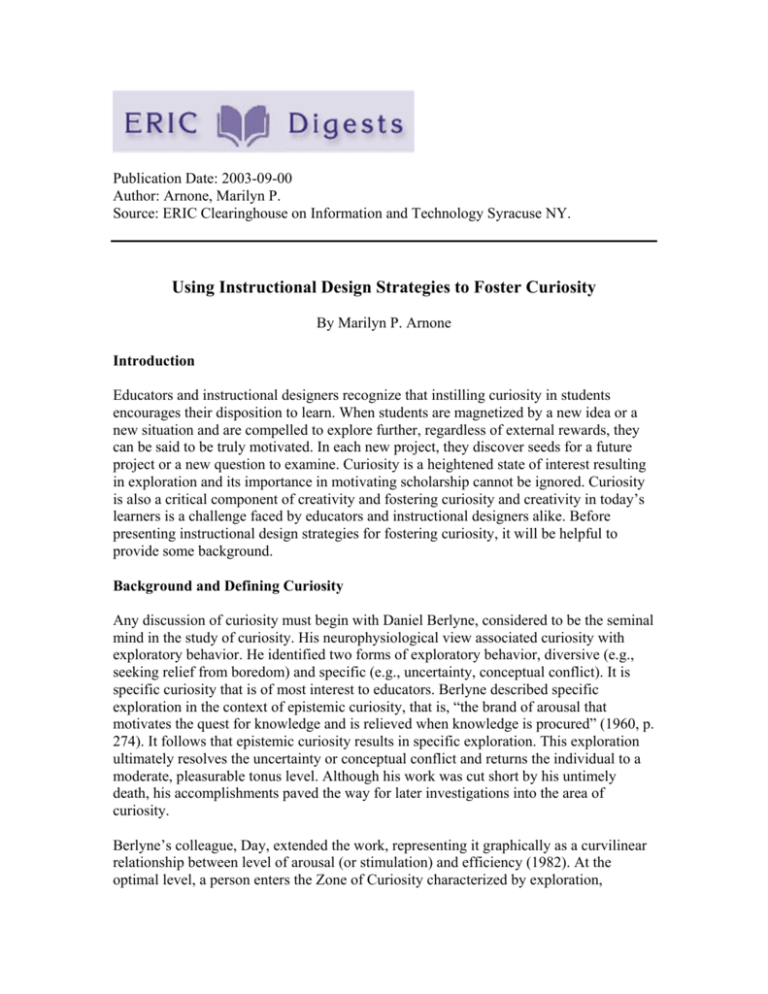
Publication Date: 2003-09-00 Author: Arnone, Marilyn P. Source: ERIC Clearinghouse on Information and Technology Syracuse NY. Using Instructional Design Strategies to Foster Curiosity By Marilyn P. Arnone Introduction Educators and instructional designers recognize that instilling curiosity in students encourages their disposition to learn. When students are magnetized by a new idea or a new situation and are compelled to explore further, regardless of external rewards, they can be said to be truly motivated. In each new project, they discover seeds for a future project or a new question to examine. Curiosity is a heightened state of interest resulting in exploration and its importance in motivating scholarship cannot be ignored. Curiosity is also a critical component of creativity and fostering curiosity and creativity in today’s learners is a challenge faced by educators and instructional designers alike. Before presenting instructional design strategies for fostering curiosity, it will be helpful to provide some background. Background and Defining Curiosity Any discussion of curiosity must begin with Daniel Berlyne, considered to be the seminal mind in the study of curiosity. His neurophysiological view associated curiosity with exploratory behavior. He identified two forms of exploratory behavior, diversive (e.g., seeking relief from boredom) and specific (e.g., uncertainty, conceptual conflict). It is specific curiosity that is of most interest to educators. Berlyne described specific exploration in the context of epistemic curiosity, that is, “the brand of arousal that motivates the quest for knowledge and is relieved when knowledge is procured” (1960, p. 274). It follows that epistemic curiosity results in specific exploration. This exploration ultimately resolves the uncertainty or conceptual conflict and returns the individual to a moderate, pleasurable tonus level. Although his work was cut short by his untimely death, his accomplishments paved the way for later investigations into the area of curiosity. Berlyne’s colleague, Day, extended the work, representing it graphically as a curvilinear relationship between level of arousal (or stimulation) and efficiency (1982). At the optimal level, a person enters the Zone of Curiosity characterized by exploration, excitement, and interest. Below the optimal level, the individual is unmotivated, disinterested, and inefficient. Beyond the optimal level, the individual enters a Zone of Anxiety with resulting behaviors including defensiveness, disinterest, avoidance, and inefficiency. This curvilinear explanation of curiosity was used in later studies including in an instructional design context exploring differences in young learners’ curiosity and achievement in an electronic learning environment (Arnone & Grabowski, 1992, Arnone, Grabowski, & Rynd, 1994). A number of researchers have placed more weight on cognitive and information processing factors in explaining curiosity (e.g., Beswick, 1968; Malone, 1981). Loewenstein (1994) proposed an information-gap theory of specific epistemic curiosity where a feeling of deprivation occurs when an individual becomes aware of a difference between “what one knows and what one wants to know” (p.87). Maw and Maw’s (e.g., 1964) studies resulted in an operationalized definition of curiosity that continues to be useful: “…curiosity is demonstrated by an elementary school child when he: 1. reacts positively to new, strange, incongruous, or mysterious elements in his environment by moving toward them, by exploring, or by manipulating them, 2) exhibits a need or a desire to know more about himself and/or his environment, 3) scans his surroundings seeking new experiences, and 4) persists in examining and exploring stimuli in order to know more about them” (p. 31). Whatever explanation one accepts, it cannot be dismissed that curiosity is a necessary ingredient for motivating scholarship. In his motivational design model for enhancing instruction, Keller (1987) acknowledges the important role that stimulating curiosity plays in gaining and sustaining learners’ attention, the first component of his model. In fact, it has been argued that curiosity is an equally important factor in each of the other components - relevance, confidence, and satisfaction (Arnone & Small, 1995). Individual Differences Not everyone is equally curious. Curiosity can be viewed as both a stable personality feature (trait) and as a condition that can be manipulated (state). Naylor (1981) describes trait curiosity as individual differences in capacity to experience curiosity, and state curiosity as individual differences in response to a curiosity-arousing situation. Strategies That Foster Curiosity in Learners Most educators would agree that fostering the scholarly attribute of curiosity in learners is an important task. Providing students with adequate guidance while affording them the opportunities for exploration, however, is probably easier stated than accomplished. As mentioned earlier, not all students are highly curious and what might stimulate curiosity in some students might result in anxiety for others. It becomes the job of the educator and/or instructional designer to recognize these differences and control the classroom or other learning environment to accommodate all learners. With this caveat in mind, the following are ten instructional design strategies for fostering curiosity. Strategy #1: Curiosity as a Hook Use curiosity as a primary motivator at the beginning of a lesson by starting, for example, with a thought-provoking question or surprising statement (Small & Arnone, 2000). Strategy #2: Conceptual Conflict Introduce a conceptual conflict when possible. Learners will feel compelled to explore the conflict until it is resolved. When the student has resolved the conceptual conflict, he/she will sense a feeling of satisfaction. Strategy #3: An Atmosphere for Questions Create an atmosphere where students feel comfortable about raising questions and where they can test their own hypotheses through discussion and brainstorming. Not only does this foster curiosity but it also helps to build confidence. Strategy #4: Time Allow adequate time for exploration of a topic. If the teacher has been successful in stimulating curiosity, then learners will want to persist in that exploration. Strategy #5: Choices Give students the opportunity for choosing topics within a subject area. For example, in a writing class, the student can explore a topic of his/her interest while accomplishing the goals of the writing task. Being allowed to choose a topic that is intrinsically motivating will help sustain curiosity. Strategy #6: Curiosity-Arousing Elements Introduce one or more of the following elements into a lesson to arouse curiosity: Incongruity Contradictions Novelty Surprise Complexity Uncertainty Learners will desire to explore the source of the incongruity, contradiction, novelty, uncertainty, etc., and the resulting information will satisfy their curiosity. Strategy #7: The Right Amount of Stimulation Be aware of the degree of stimulation that is being entered into the learning situation. Remember, there are individual differences when it comes to curiosity. Some learners will become anxious if the stimulus is too complex, too uncertain, too novel, etc. (Gorlitz, 1987). They may quickly leave what Day (1982) refers to as the Zone of Curiosity and enter the Zone of Anxiety. Strategy # 8: Exploration Encourage students to learn through active exploration. Strategy #9: Rewards Allow the exploration and discovery to be its own reward. “Exploration is self-rewarding (Day, 1982, p.19).” Use external rewards judiciously as some studies have shown that extrinsic rewards given for a task that a learner finds intrinsically motivating may dampen future interest in the activity. Strategy #10: Modeling Model curiosity. Ask questions. Engage in specific exploration to resolve a question posed, and demonstrate enthusiasm. Conclusion To instill curiosity in students is to encourage their disposition to learn. To ignore its importance is to risk diminishing, if not losing, the endowment of curiosity conferred upon all at birth. References Alberti, E.T. & Witryl, S.L. (1994). The relationship between curiosity and cognitive ability in third and fifth-grade children. The Journal of Genetic Pyschology, 155(2), 129145. Arnone, M. P. & Small, Ruth V. (1995) Arousing and Sustaining Curiosity: Lessons from the ARCS Model. In 17th Annual Proceedings of Selected Research and Development Presentations, National Convention of the Association for Educational Communications and Technology (Anaheim, CA).1-15. Arnone, M., Grabowski, B., & Rynd, C. (1994). Curiosity as a Personality Variable Influencing Learning in a Learner Controlled Lesson With and Without Advisement. Educational Technology Research and Development, 42(1), 5-20. Arnone, M. & Grabowski, B. (1992). Effects on Children’s Achievement and Curiosity of Variations in Learner Control Over an Interactive Video Lesson. Educational Technology Research and Development, 40(1), 15-28. Berlyne, D.E. (1960). Conflict, Arousal, and Curiosity. New York: McGraw-Hill. Beswick, D. (1968). Cognitive process theory of individual differences in curiosity. In H. Day, D.Berlyne, & D. Hunt (Eds.) Intrinsic Motivation: A New Direction in Learning. Toronto: Rinehart and Winston of Canada. Day, H.I. (1982). Curiosity and the interested explorer. NSPI Journal, May, 19-22. Gorlitz, D. (1987). Curiosity, Imagination, and Play: On the Development of Spontaneous Cognitive and Motivational Processes. Hillsdale, NJ: Lawrence Earl Baum Associates. Keller, J. M. (1987 Nov./Dec.). The systematic process of motivational design. Performance & Instruction, 1-8. Loewenstein, G. (1994). The psychology of curiosity: A review and reinterpretation. Psychological Bulletin, 116(1), 75-98. Malone, T. W. (1981). Toward a theory of intrinsically motivating instruction. Cognitive Science, 4, 335-369. Maw, W. & Maw, E. (1964). An exploratory study into the measurement of curiosity in elementary school children. Cooperative Research Project No. 801. Naylor, F.D. (1981). A state-trait curiosity inventory. Australian Psychologist, 16(2), 172-183. Small, R.V. & Arnone, M.P. (2000). Turning Kids On to Research: The Power of Motivation. Englewood, CO: Libraries Unlimited. The Author Marilyn P. Arnone produces media projects for the child audience that encourage curiosity for learning and promote information literacy such as "The Strangest Dinosaur That Never Was" published by Libraries Unlimited in 2003. She has co-authored several books for educators including "Turning Kids On To Research: The Power of Motivation." Dr. Arnone is Director of Educational Media at the Center for Digital Literacy and an adjunct professor at the School of Information Studies at Syracuse University, and is President of Research and Development at Creative Media Solutions, Oriental, NC.
